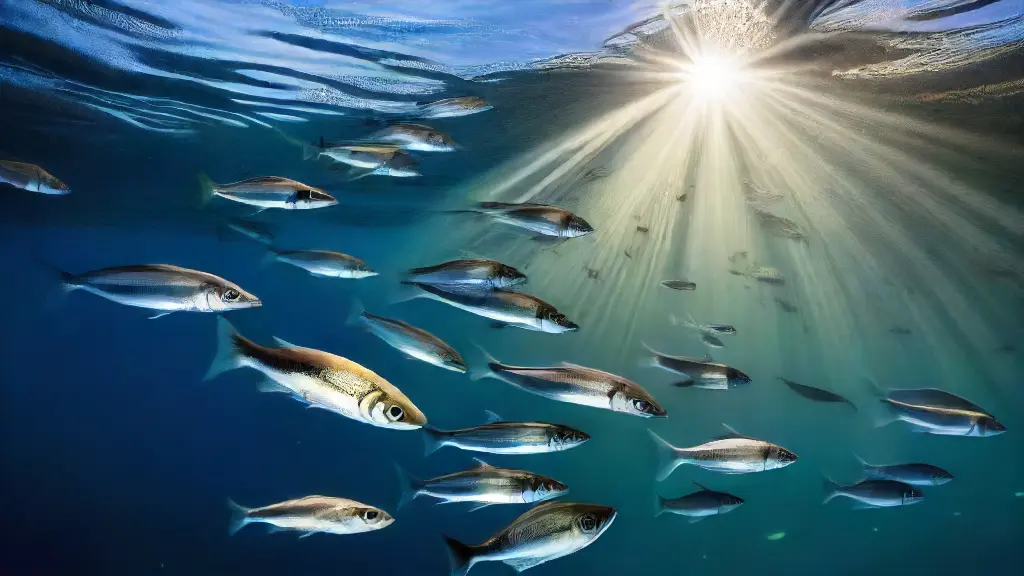How Bait Fish React to Changes in Light

Unlocking the Secrets of Bait Fish Behavior. In the aquatic life, tiny changes in light intensity can have a profound impact on fish behavior, making them more susceptible to lures during specific periods of the day.
Many anglers underestimate the significance of these changes, often resulting in missed opportunities and increased frustration on the water.
How bait fish react to changes in light can significantly influence their activity and movement patterns, which ultimately affects the likelihood of catching them.
As the sun rises and sets, light intensity and quality change, influencing the behavior of bait fish and their reactions to lures. Understanding how light affects bait fish behavior can be the key to increasing catch rates and success on the water. Fish tend to be highly attuned to their aquatic environment.
What Are Light Sensitive Fish
The aquatic world is a realm where creatures have evolved remarkable strategies to survive and thrive. Fish that inhabit these environments have developed extraordinary physiological adaptations to navigate the dynamic light conditions that dictate their daily habits and survival.
In the underwater world, light plays a crucial role in governing the daily rhythms and activities of fish.
Some species have evolved to be extremely sensitive to light, relying on visual cues to guide their movements, find food, and avoid predators.
The spectral sensitivity of certain fish allows them to detect even the faintest light wavelengths, helping them to adjust their behavior accordingly. For example, some species can adjust their hunting patterns based on the light conditions, while others use it to communicate with potential mates.
Not all fish are equally sensitive to light, and some have developed remarkable behavioral adaptations to cope with changes in light conditions. These adaptations enable them to navigate their surroundings with enhanced visual acuity and spatial awareness.

Fish React to Light Cues
In the depths of aquatic environments, the subtle dance of light and darkness orchestrates the daily rhythms of fish behavior. The detection of light cues triggers a range of responses that impact their daily routines, from navigating their surroundings to finding sustenance.
Fish have an innate photoreceptor system that enables them to detect even slight changes in light intensity, which in turn influences their orientation and navigation of the aquatic ecosystem.
For instance, some fish exhibit phototaxis, moving towards or away from sources of light to avoid predators and optimize their feeding behavior.
This phenomenon is crucial for their survival, as it helps them navigate their environment and school together more effectively.
In addition to navigation, light also affects fish feeding behavior and social behavior. Many species are more active during dawn and dusk when light levels are moderate, making it easier for them to find food and interact with other fish, and this daily rhythm is a key aspect of their orientation and navigation in the aquatic ecosystem.
Facts About Fish Behavior
- Fish have an innate photoreceptor system that enables them to detect even slight changes in light intensity.
- Some fish exhibit phototaxis, moving towards or away from sources of light to avoid predators and optimize their feeding behavior.
- The detection of light cues triggers a range of responses that impact their daily routines, from navigating their surroundings to finding sustenance.
- Many species are more active during dawn and dusk when light levels are moderate, making it easier for them to find food and interact with other fish.
How Light Affects Fish Behavior
Fish have an innate ability to detect subtle changes in their environment, which plays a crucial role in their survival and adaptability. As they navigate their surroundings, they rely heavily on visual cues, including the light that filters through the water.
Fish are visual creatures, and their behavior is deeply influenced by the light they receive from their surroundings.
Understanding how light affects fish behavior is essential for both recreational and commercial fishermen, as well as aquarium owners and aquarists.
As the sun rises and sets, fish behavior changes dramatically. Bait fish, for instance, become more active during these times, which can be an advantage for spin casting enthusiasts.
With the right rod and reel, anglers can capitalize on this increased activity, reeling in a catch with a well-placed fly fishing lure. Artificial light, on the other hand, can be particularly effective when combined with fishing gear such as rods and reels with monofilament lines or sinking baits like spin casting and baitcasting lures.
Fish Migration Patterns
As twilight descends over the ocean’s canvas, the secrets of the deep begin to unravel, revealing the ancient rhythms of the aquatic world, where fluorocarbon strands weave a tapestry of life, and fish migration patterns unfold like a masterful dance.
I.
Introduction to
Definition of fish migration refers to the regular movement of fish populations between diverse habitats, such as estuaries to open ocean or vice versa.
Understanding fish migration patterns is crucial for effective fisheries management as it helps predict and mitigate bycatch, habitat degradation, and pollution.
Several aquatic species exhibit migration, including salmonids, eels, sardines, and even iconic species like the majestic Blue Devil Damsel. Fish migration patterns are a testament to the remarkable adaptability of marine life, where braided threads of genetics, environment, and predator-prey dynamics come together in a complex weave of fluorocarbon-coated lines, precise fishing knots, and expertly curated tackle box essentials, all enhanced by the clarity provided by polarized sunglasses, fish finder guidance, GPS fish finder precision, depth sounder accuracy, and vivid underwater photography captured by aquatic cameras and camera housing.
| Importance in Fisheries Management | Examples of Migrating Species | Factors Influencing Migration | |
|---|---|---|---|
| Predicting and mitigating bycatch, habitat degradation, and pollution | Understanding fish migration patterns helps in effective fisheries management | Salmonids, eels, sardines, Blue Devil Damsel | Genetics, environment, predator-prey dynamics |
| Understanding fish behavior and habitat requirements | Helps in identifying critical habitats and conservation areas | Various fish species, including iconic ones | Fluorocarbon strands, fish migration patterns, and aquatic world rhythms |
| Informing fisheries management decisions | Essential for sustainable fishing practices | Multiple aquatic species | Polarized sunglasses, fish finder guidance, GPS fish finder precision, depth sounder accuracy, and underwater photography |
What is LightInduced Behavior
As the setting sun casts its golden glow on the underwater world, aquatic life comes alive, governed by the subtle yet profound effects of light on their daily rhythms and behaviors.
Light-induced behavior, a vital aspect of fish biology, is a complex phenomenon that has fascinated scientists for decades.
Understanding this behavior is crucial in various fields, including aquarium-keeping, fisheries management, and conservation.
For instance, knowing how fish respond to different light conditions can help aquarists recreate their natural habitats, improving the health and well-being of their underwater friends underwater light.
Photoperiodism is the scientific term for the study of how living organisms respond to the length and intensity of dive light. In the aquatic world, photoperiodism plays a crucial role in regulating the responses of fish to their underwater strobe. By understanding photoperiod, anglers can optimize the timing and effectiveness of their underwater light, dive light, submersible light, underwater strobe, fish attractor, artificial attractant, fishing lure, spinnerbait, soft plastic, crankbait, fly, dry fly, or wet fly.
Fish Visual Perception
Across diverse aquatic ecosystems, from crystal-clear streams to murky rivers and tranquil lakes, fish have developed remarkable visual adaptations to thrive in their environments.
The importance of understanding fish visual perception cannot be overstated, as it plays a crucial role in their behavior, from feeding habits to schooling and mating phases.
### How Light Influences Fish Behavior
Light intensity and quality have a significant impact on fish activity levels, with changes in ambient light triggering responses that range from increased feeding to altered migration patterns.
For instance, a baitfish pattern on a fishing line may be more attractive in low-light conditions, while a fish species from the Characidae family may be more responsive to a streamer pattern in brighter waters. Chromatic perception in fish can also be influenced by the types of visual stimuli they encounter, such as streamer, nymph, baitfish patterns, fish species, fish families, fish orders, fish classes, fish habitats, aquatic zones, water bodies, lakes, rivers, streams.
- Fish have developed remarkable visual adaptations to thrive in their environments, such as changes in pupil size, lens shape, and retinal structure.
- Light intensity and quality have a significant impact on fish activity levels, with changes in ambient light triggering responses that range from increased feeding to altered migration patterns.
- Chromatic perception in fish can be influenced by the types of visual stimuli they encounter, such as streamer, nymph, baitfish patterns, and other visual cues.
- Understanding fish visual perception is crucial for effective fishing strategies, as it allows anglers to mimic the visual stimuli that attract fish and increase their chances of catching them.
How Fish Adapt to Light
In the depths of aquatic ecosystems, a fascinating phenomenon unfolds, as fish develop ingenious adaptations to thrive in diverse light conditions. From the subtle nuances of dawn’s golden glow to the harsh intensity of midday sun, fish have evolved remarkable strategies to navigate the complex interplay of light and water.
Photoreception: How Fish Sense Light
Fish have specialized photoreceptors in their eyes, capable of detecting even the subtlest changes in light intensity and color.
Circadian Rhythms: How Light Influences Fish Behavior
Diurnal fish, like the golden shiner, are active during the day, while nocturnal fish, like the catfish, thrive in the dark.
Chromatic Adaptation: How Fish Respond to Light Color
Some fish, like the mandarinfish, can change the color of their skin to blend in with their surroundings.
Fish Ability to Detect Light
In the depths of our oceans and in the tranquility of freshwater lakes, a fascinating phenomenon unfolds, where creatures of the aquatic world have evolved to thrive in harmony with the infinite shades of light. Aquatic ecology research has shown that fish behavior, influenced heavily by the visual system, plays a crucial role in shaping their daily lives, from navigating their surroundings to finding food and avoiding predators.
The fish brain is uniquely attuned to detect and respond to subtle changes in light intensity, duration, and spectrum.
Ecological studies reveal that fish rely heavily on visual cues to navigate their environment, find food, and coexist with other species.
From the radiant glow of sunlit waters to the soft luminescence of moonlight, fish have evolved to adapt to a wide range of lighting conditions. Fish behavior studies have revealed that different species exhibit distinct patterns of aggregation and interaction.
Best Techniques for Using Bait Fish in Vegetation
Best Practices for Using Bait Fish in Stagnant Water


